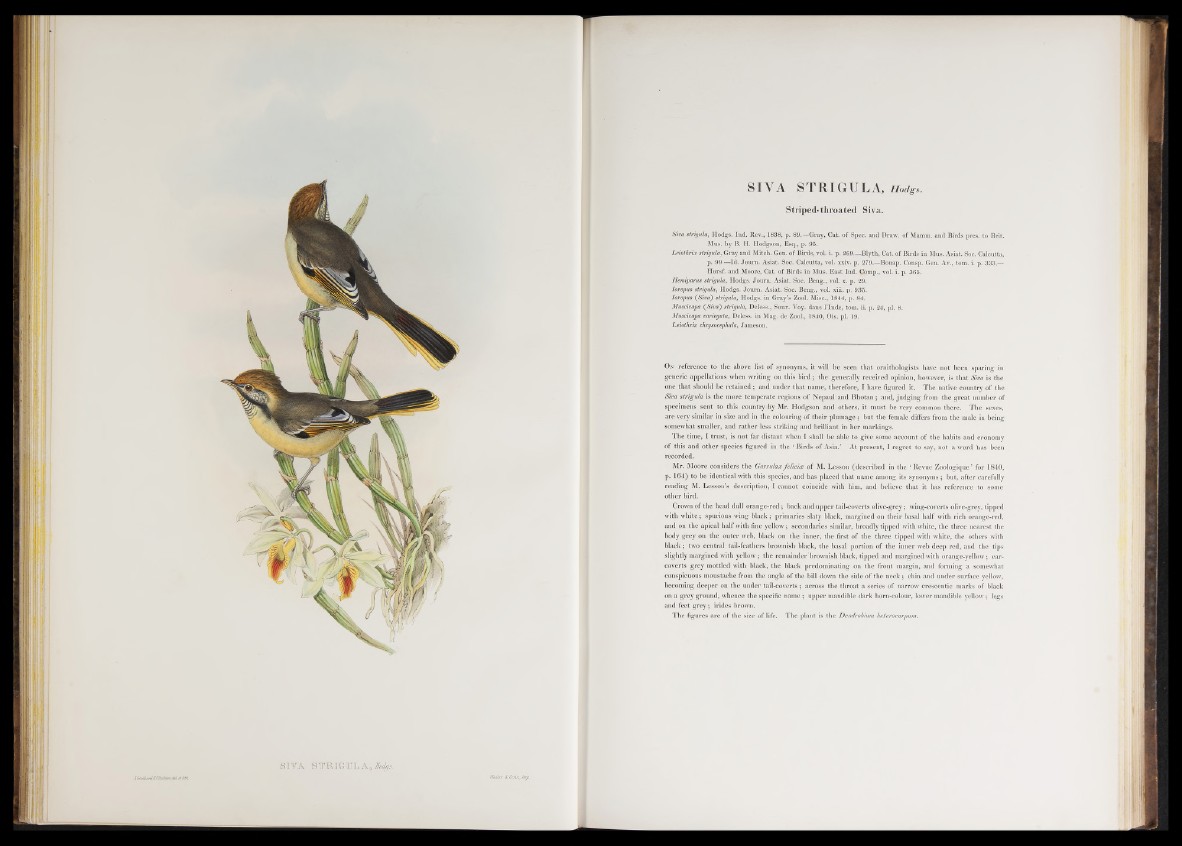
SGmldaniHCJtirhUr.dtlcllith
SIVA STR IG U LA , Xiulgs.
Waller i Co/in., Imp.
SIVA STRIGULA, Hodgs.
Striped-throated Siva.
Siva strigula, Hodgs. Ind. Rev., 1838, p. 89.—Gray, Cat. of Spec, and Draw, of Mamm. and Birds pres, to Brit.
Mus. by B. H. Hodgson, Esq., p. 95.
Leiothrix strigula, Gray and Mitch. Gen. of Birds, vol. i. p. 269.—Blyth, Cat. of Birds in Mus. Asiat. Soc. Calcutta,
p. 99.—Id. Journ. Asiat. Soc. Calcutta, vol. xxiv. p. 279.—Bonap. Consp. Gen. Av., tom. i. p. 333.—
Horsf. and Moore, Cat. of Birds in Mus. East Ind. {§omp., vol. i. p. 365.
Hemiparus strigula, Hodgs. Joum. Asiat. Soc. Beng., vol. x. p. 29.
Ioropus strigula, Hodgs. Journ. Asiat. Soc. Beng., vol. xiii. p. 935.
loropus (Siva) strigula, Hodgs. in Gray’s Zool. Misc., 1844, p. 84.
Muscicapa (Siva) strigula, Deless., Souv. Voy. dans l’lnde, tom. ii. p. 24, pi. 8.
Muscicapa variegata, Deless. in Mag. de Zool., 1840, Ois. pi. 19.
Leiothrix chrysocephala, Jameson.
On reference to the above list of synonyms, it will be seen that ornithologists have not been sparing in
generic appellations when writing on this b ird ; the generally received opinion, however, is that Siva is the
one that should he retain ed ; and under that name, therefore, I have figured it. The native country of the
Siva strigula is the more temperate regions o f Nepaul and Bhotan; and, judging from the great number of
specimens sent to this country by Mr. Hodgson and others, it must be very common there. The sexes,
are very similar in size and in the colouring of their plumage; but the female differs from the male in being
somewhat smaller, and rather less striking and brilliant in her markings.
The time, I trust, is not far distant when I shall be able to give some account of the habits and economy
of this and other species figured in the ‘ Birds of Asia.’ At present, I regret to say, not a word has been
recorded.
Mr. Moore considers the Garrulax felicice o f M. Lesson (described in the ‘ Revue Zoologique ’ for 1.840,
p. 164) to be identical with this species, and has placed that name among its synonyms; but, after carefully
reading M. Lesson’s description, I cannot coincide with him, and believe that it has reference to some
other bird.
Crown of the head dull orange-red; back and upper tail-coverts olive-grey; wing-coverts olive-grey, tipped
with white; spurious wing black; primaries slaty black, margined on their basal half with rich orange-red,
and on the apical half with fine yellow; secondaries similar, broadly tipped with white, the three nearest the
body grey on the outer web, black on the inner, the first of the three tipped with white, the others with
black; two central tail-feathers brownish black, the basal portion of the inner web deep red, and the tips
slightly margined with yellow; the remainder'brownish black, tipped and margined with orange-yellow; ear-
coverts grey mottled with black, the black predominating on the front margin, and forming a somewhat
conspicuous moustache from the angle of the bill down the side of the n eck ; chin and under surface yellow,
becoming deeper on the under tail-coverts; across the throat a series of narrow crescentic marks of black
on a grey ground, whence the specific name ; upper mandible dark horn-colour, lower mandible yellow; legs
and feet g rey ; irides brown.
The figures are of the size of life. The plant is the Dendrobium heterocarpum.